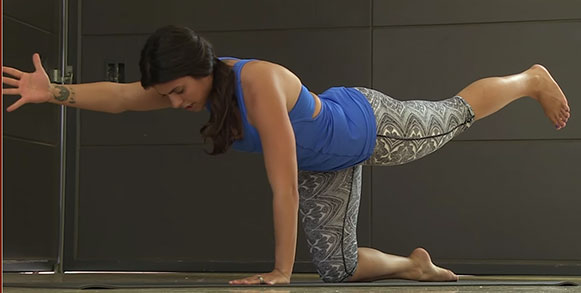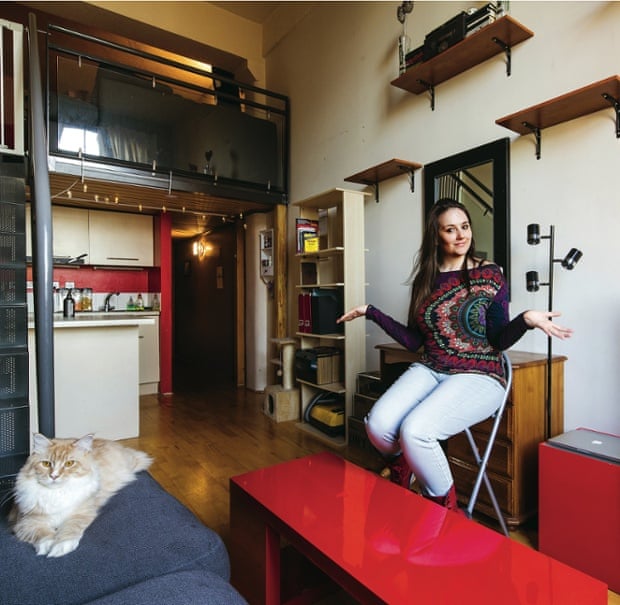Lead Photo Credit: CrossFit Ocean Isle Beach
- CrossFit is the fastest growing fitness pursuit, but some of the things participants do are questionable from a health standpoint.
- According to Dr. Stuart McGill, the spine is most at risk when it's flexed and loaded with high compression and when it extends while still bearing the high compression.
- Fatigue from heavy, high-rep lifts can cause deterioration of lifting form leading to a higher incidence of disc bulges and herniation.
- Dr. McGill says CrossFit could improve by making a few simple changes, like decreasing the number of reps required on Olympic lifts.
The Fittest on Earth... For a Year

Like it or not, CrossFit is here to stay, and in a big way. With over 10,000 CrossFit facilities and counting, it's become the household name in fitness.
And every year the CrossFit Games brings in hundreds of thousands of competitors to determine who "the fittest on earth" will be.
So what's next for CrossFit? Maybe cleaning up some of the issues that will make fittest-on-earth contenders debilitated-for-life later on down the road.
Notes From A Physical Therapist

As a sports performance physical therapist, CrossFit has been on my professional radar for years. Both CrossFit athletes and facilities have sought my services.
One of the biggest misconceptions I hear is that
all CrossFit athletes are chronically sidelined with debilitating injuries. This isn't accurate and the reason for the spike in physical therapy may surprise you.
Good physical therapists are movement specialists and coaches above all else. The focus in my professional work with high-level athletics such as CrossFit has gravitated more towards injury prevention and pre-habilitation than traditional rehab.
Screening, evaluating, and preventing future injuries makes up a majority of my cases with CrossFit athletes over the past few years. Just as with any other competitive sport, there will always be an influx of chronic and traumatic injuries. That's part of the game.
Does CrossFit Hurt People?

I only have so much anecdotal evidence behind my claims that CrossFit may be one of the most debilitating forms of training.
While research is incomplete, it's important to justify or refute these claims regarding CrossFit-specific injury rates as the world's fastest growing athletic specialty continues to grow.
This is a tall task. To set the record straight, I spoke with one of the top thinkers in biomechanics to get his perspective on CrossFit.
Insights From Dr. Stuart McGill
Dr. Stuart McGill is considered one of the world's top spinal specialists and researchers.
He's been sought out by corporations, the government, elite athletes, and professional sports teams for his expertise in injury prevention, programming, and rehabilitation.
Related: Back to McGill
Dr. McGill has made enough groundbreaking advancements in his field to carry an opinion backed by science that speaks volumes.
I had the chance to get his take on CrossFit. Here's what he had to say.
Dr. Rusin: Is CrossFit inherently dangerous?
Dr. McGill: My expertise is in back injury, so that is the perspective from which I view controversial topics such as this. For the record I have a love-hate relationship with CrossFit.
I don't think "dangerous" is the right word, but certainly "injury risk" is appropriate and it facilitates discussion of practices that influence injury risk, injury mechanisms, and injury rates.
A major component of CrossFit is Olympic lifting. Olympic lifting must find the lifter. Not the other way around given the special anatomical gifts needed to lift with efficiency and injury resiliency.
The flexibility required in the hips and shoulders in many cases is a gift from your parents. No matter how much stretching is attempted, some will never have the hip and shoulder socket anatomy to deep squat and support a bar overhead. But they will try, and their compromised form will create substantial injury mechanisms.
The majority I see are spine disc bulges and vertebral end plate fractures. Most of these fractures are undetected by radiologists reporting on MRI, CT, and x-ray scans.
 Dr. Rusin:
Dr. Rusin: What can the average CrossFit coach without a strong background and focus on the Olympic lifts do to identify at-risk athletes while also keeping their clients and athletes safe?
Dr. McGill: This is a difficult challenge for any coach. Anyone can play basketball with little risk but this cannot be said for the Olympic lifts.
The next issue is that programming within a CrossFit routine can be problematic.
World-class Olympic lifters train with very few reps – usually just singles and doubles. They have also learned to never miss a lift, never lift when fatigued, and never compromise form.
They do not create muscle memory polluted with fatigued patterns. This approach creates faster gains in performance and less injury.
I have known several Olympic lifters over the years who are unanimous in stating that their back injury was tuition. It taught them never to lift with compromised form again. One went on to set multiple world records.
Dr. Rusin: What are the most common causes of injury?

Dr. McGill: The spine's discs are quite tough and resilient to high load when they're not bent but remain in a neutral posture. Second best is when they are flexed and then loaded, but they must not move.
Think of flexing the spine when picking up an atlas stone and the spine is curled over the stone and lifted with extension at the hips – the spine stays locked.
The injury bogeyman appears when the spine is flexed and then loaded with high compression, and then it extends while still bearing the high compression.
Here, high reps of these bending movements while under the high loads from the bar slowly delaminate the collagen fibers that form the outer rings of the disc.
Eventually the cumulative effect is the gel-like nucleus of the disc seeps through the delaminations causing a disc bulge. We have performed dozens of experiments over the years to prove this.
Dr. Rusin: It's well accepted that placing the spine in a flexed position under daunting loads is a bad thing. But don't Olympic lifters endure the same types of stresses as CrossFit athletes executing Olympic lifts within programing or WODs?
Dr. McGill: This is the distinction between the real Olympic lift competitors and CrossFit athletes.
The high repetitions and deterioration of lifting form from fatigue in CrossFit athletes causes a higher incidence of disc bulges and herniations. I rarely have to deal with these injuries in the Olympic athletes – typically they have healthy backs but succumb to shoulder, knee, and hip injuries.
Related: 4 Most Damaging Types of Training
But CrossFit compounds the risk further. Olympic athletes toughen the collagen in their spine discs by only training mobility in the ball and socket joints.
CrossFit athletes must perform exercises like burpees. Performing ten burpees before ten snatches replaces disc toughness with flexibility and softness in the matrix holding the collagen fibres together, resulting in a more potent injury risk scenario.
Many athletes have, and will, pay the price with years of back pain misery.
 Dr. Rusin:
Dr. Rusin: So CrossFit-specific programming can be risky for lower back health. By now, don't coaches and programing coordinators over at the CrossFit HQ know this?
Dr. McGill: While attending the CrossFit competition at the Arnold Classic, one thing really stood out: the lifting technique was just awful.
I did not see one competent lift. Not one! And things only got worse with each rep and set. (I will note that I have consulted before with some CrossFit gyms and there are some very competent lifters.)
No corrections from the coaches, only encouragement to continue lifting. The injured athletes went down to the medical tent where I saw very strange and, in my view, inappropriate chiropractic and physical therapy approaches being administered.
Dr. Rusin: What were they doing?

Dr. McGill: They were putting athletes into flexion positions and applying manual technique to their back muscles making the situation worse.
The clinicians appeared not to understand the mechanisms causing the athletes pain – they had disc pain.
I suspect athletes think injury will not happen to them, and that lifting form during fatigue is not going to catch up to them, but maintaining good form is that important.
Dr. Rusin: How do CrossFit athletes compare to other elite level athletes you've worked with?
Dr. McGill: I'm not able to answer the question, "Who are the greatest athletes?" But I can address the training and whether or not it creates the best athleticism in the individual.
The programming based on going to failure with speed and high load will shorten the athletic window of many of these people. But can I say anything different for MMA, American football, and many other sports?
Training to compete in the CrossFit Games is about creating a very special competency, but our work shows it does not create the best transfer. I don't know how transferable it is to other activities and sports.

Fitness variables compete with one another. For example, one cannot train for maximum explosive power and still train for endurance.
It's not possible to enhance the fast twitch mechanisms for maximum speed and strength while enhancing fatigue resiliency by challenging the slow twitch metabolism. But this contrast does not necessarily lead to injury – only a poorer specialized athlete.
Dr. Rusin: So are you saying that CrossFit-specific programming can hinder an athlete's potential athletic development in sports other than CrossFit?

Dr. McGill: The programming within CrossFit will only create a better CrossFit competitor. There are better ways to build a faster running back in football, a better rower, a better Olympic lifter, etc. Decreasing the volume of reps is just one variable, among many, that would need optimizing.
Some will argue that some CrossFit events requiring torso-bending power such as the seated overhead medicine ball throw creates athletic competency.
Dr. Rusin: I have argued that the GHD medicine ball toss is one of the single most risky movements in CrossFit, period. So, does the ball toss create any athletic competency?
Related: Does CrossFit Lead to Injury?
Dr. McGill: I would argue that each individual only has a defined amount of training capacity. A much better set of exercises could be programmed to achieve the athletic competency without using up so much of the available training capacity.
Again, the programming is not designed to allow maximum athletic development while reducing the injury risk. The point is, risk could be mitigated, and athletic variables increased with more thought directed at programming.
Dr. Rusin: One of your recent studies – relevant to this discussion of fitness and injury risk – revealed that fitter police and firefighters got hurt sooner.
Dr. McGill: We tested several hundred firefighters together with a police SWAT team for athletic variables: biomechanical, physiological, range of motion, endurance – a robust battery of tests.

Then we followed the firefighters for three years and the police for five. The results were the same: the fitter ones got hurt more.
Then we analyzed the injury mechanisms – the majority of injuries did not occur on duty but rather in the weight room, and they were training in the style of lifting to failure and compromising form.
The guys who trained more moderately were slightly less fit, but they were sufficiently fit, and more injury resilient. This just shows that programming matters.
Dr. Rusin: In your view, what's the most positive aspect of CrossFit that we can all learn from?
Dr. McGill: Of course, I see many positives. In CrossFit, I see people rallying around physical activity that may not otherwise become involved. When I was younger, I would have loved this – the tougher the challenge, the better.
In high school and college I trained for strength and size, then later for specific athleticisms involving speed and strength. But then I had to tone down the intensity as the mileage on my body was showing with pain and slower recovery from injury and training.
By my early 50s I made a conscious decision to make it to retirement with as much remaining athleticism as possible. Now I look around and see my contemporaries who still have their joints – and they were not the ones who thought intense training when they were younger would give them good fitness through the lifecycle.
This is only achieved with moderation.
But having stated that, I am equally dismayed by many of the students at my university who are so soft and untrained that they will suffer the health consequences of being physically weak.
If I could influence them, I would coach them in movement competency then send them to CrossFit; but a CrossFit facility concentrated on proper movement and science-based programming methodology, of course!
 Dr. Rusin:
Dr. Rusin: What would you do if you could run CrossFit for a day?
Dr. McGill: That's a fair question and the right question for anyone who wants the right to voice an opinion. It puts it in perspective.
From a programming point of view, I would reduce the number of reps of Olympic lifts. Perhaps modify programming to singles or doubles at the beginning of a sequence. But there would need to be a way to test competency.
I would not add volume to an event that had an inherent risk for tissue damage, like the Olympic lifts, or the seated med ball throw up and over the roman chair. In fact I would drop that event as it steals resiliency from the lifts.
Actually, if reps were required, I would ban it. The laws of human motion with injury resiliency begin first with proximal stiffness enhances distal athleticism, and secondly, generate power at hips, not the spine. This will create a more competent and injury resilient athlete.

So we have a list of things that you would omit from CrossFit-style programming. Are there any additions that you'd like to see in CrossFit?
Dr. McGill: Some more variety in the events to include obstacle courses, and more endurance holds, like a new military plank hold. These would maintain the mental toughness element that is a wonderful feature of CrossFit.
Interestingly this seems to be the direction of the Spartan races and Tough Mudder events. The natural team-building that occurs is wonderful. No wonder participation is growing among police, firefighter, and military groups.
We're just publishing a study where we trained a group of firefighters with a program of substantial repetitions and weights but we did not coach form – the emphasis was on completing the reps. This will sound familiar to the CrossFit community.
In a second group we had a coach insist on good form for every rep, stopping when form broke, and continually correcting.

Both groups enhanced their fitness. However, we tested their movement competency in high-demand firefighting tasks following the training sessions. The coached group moved with more competencies and fewer injury mechanisms. The high-rep, go-to-failure, form-compromising group had more injury mechanisms in their movements.
From this perspective, transference of movement skill to other events, together with fitness, required a disciplined training approach. Our data showed that performing more reps without focusing on technique did not transfer as well to other activities, while the disciplined movement form approach did.
CrossFitters interested in being better athletes with fewer injuries will be interested in this – and adjust their programming approach as a result.
Dr. Rusin: This could clean up the high incidence of injuries secondary to CrossFit programming and participation. It may broaden the scope of what CrossFit could be capable of for the transfer of athleticism into other sports.
Dr. McGill: Variety of events would absolutely assist in better transference of athleticism to other sports, and reduce injury risk.
Some strongman events would better test grip strength, frontal plane strength and isometric endurances that are lacking in many CrossFit routines. This would require the CrossFit executives to expand the brand.
Adding movement competency judging to CrossFit would reduce injury risk. Some events are currently judged for example achieving the chin to bar – but this is to count reps based on a performance metric. Judging the lifts for form and skill would be best, but difficult to administer.
Dr. Rusin: While I agree it would be great to have a metric for movement competency and execution, doesn't it all start at the foundation of coaching?

Dr. McGill: Coaches need a lot of training. I am so disappointed when I hear coaches yelling at an incompetent lifter to keep trying for more reps with awful form. This is common on YouTube clips and is poor press for CrossFit.
A great coach assesses their athletes for injury history, body type, current athleticisms, and training goals, then creates a program while training best technique. A poor coach beats a client up and makes them sore.
Related: The Future of CrossFit Training
Dr. Rusin: That is one of the biggest misconceptions I see all over the fitness industry: the assumption that overly hard training methodology that routinely puts an athlete into the ground will produce optimal results when compared to more intelligently and goal-oriented programming.
There's a big difference between programming a movement to be "hard" and programming to be "challenging."
Dr. McGill: Absolutely. Clearly some people do not have the competency to pull a bar from the floor. They should be pulling from blocks. I suspect that incorporating this modification would reduce a lot of CrossFit lifting related injuries.
Dr. Rusin: So how can we protect our CrossFit athletes?

D
r. McGill: No athlete can stay in peak fitness for very long without becoming sick or breaking down. The combat sports have instituted commissions to reduce the number of fights or to monitor a fighter before reinstating their competition status.
Legislation to limit training volume for cricket bowlers (similar to baseball pitchers) in Australia is another example that these approaches reduce injury rates while preserving high performance.
Some equivalent institutional or legislative mechanism from the CF head office would assist serious CrossFit athletes


















